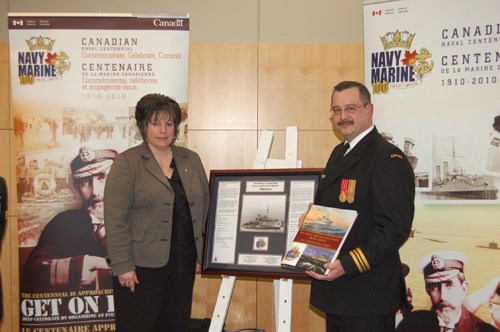15 honoured at Saskatchewan War Memorial...
A plaque honouring 15 Saskatchewan men and women who died during the Canadian military mission in Afghanistan was unveiled at the Saskatchewan War Memorial in Regina on October 23.
Since the mission began in 2002, 152 Canadian soldiers have been killed, 14 of which were from Saskatchewan.
The plaque named soldiers Lieut. Andrew Nutall, Lieut. Justin Boyles, Capt. Nichola Goddard, Cpl. Bryce Keller, Master Cpl. Jeff Walsh, Cpl. David Braun, Cpl. Shane Keating, Cpl. Jordan Anderson, Cpl. Cole Bartsch, Cpl. James Hayward Arnal, Master Cpl. Josh Roberts, Cpl. Dustin Wasden, Sgt. Prescott Shipway and Sgt. Darby Morin.
Also listed on the plaque was journalist Michelle Lang, who died while on assignment in Afghanistan.
Weyburn's contribution to the Royal Canadian Navy was honoured recently on the 67th anniversary of the sinking of the city's namesake ship, the HMCS Weyburn. Representatives of the Navy presented the city with a pictorial history of the ship and honoured one of Weyburn's only remaining Navy veterans, James Allan Day.
The presentation was made in Weyburn to commemorate the centennial of the Royal Canadian Navy (RCN) in 2010. Similar presentations are being made across Canada to over 300 communities with ships named after them.
Representing the RCN at the celebration, commanding officer of the HMCS Queen, Lieutenant Commander Corey Thiemann said that while Weyburn is a land-locked community, the Navy has an effect on the lives of prairie people by providing security to the world's ocean-going ships, by which Canada's grain is shipped.
Thiemann also explained that during wartime, communities with namesake ships would send care-packages to the seamen on the ship, as the people of Weyburn did during World War II.
There has only been one vessel named Weyburn in the RCN. She was commissioned at Montreal on November 26, 1941 and arrived at Halifax shortly after, joining the Halifax Force for local escort work.
In September 1942, HMCS Weyburn was allocated to duties in connection with Operation Torch, the Allied landings in North Africa. After being fitted with extra anti-aircraft guns she began a four-month deployment as escort to United Kingdom-Mediterranean convoys.
On February 22, 1943 HMCS Weyburn struck a mine laid off Gibraltar by German submarine U-118 and was lost with seven of her ship's 85-crewmen company.
A few current and former Weyburnites have ties to the RCN, according to Royal Canadian Legion member Day. He said that former local and grandson of Weyburn Walk of Famer Neil McKinnon, Neil Agnew, was a lieutenant in the RCN, serving on the HMCS Red Deer during the end of WWII.
Now deceased, Frank Dufour served with the RCN, protecting freight ship convoys. Nick Elchuk, also deceased, served in the Mediterranean on the RCN Tribal Class destroyer, HMCS Cayuga, during the landing at Normandy.
As for himself, Day said he joined the RCN in 1953.
One of Weyburn's only remaining Navy veterans, James Allan Day joined the Royal Canadian Navy (RCN) in 1953 to follow his dream.
"My big dream when I first went into the Navy was that I wanted to fly," said Day.
And fly he did after training to become an Observers Mate with the Royal Canadian Naval Air Service in 1955. This qualification came after working as an Air Fitter, or an aero-engine mechanic, for two years.
Day was stationed at HMCS Shearwater where he took part in training flights on the East Coast.
One training flight took Day and his crew across the Bermuda Triangle, which had mixed results.
"It took us 5.3 hours to get there and 6.5 hours to get back," Day laughed.
In 1956, Day went to sea on the HMCS Magnificent, an aircraft carrier.
"I had two occasions when I was on the Magnificent that were touch-and-go," said Day.
His first experience happened during a reconnaissance exercise in the North Atlantic Ocean. Day said when his crew returned to the ship to land their Avenger aircraft, they were hit by a giant wave which bent their propeller and forced them to make an emergency landing.
Another reconnaissance exercise had him detect a submarine that was not part of the exercise, much to the surprise of his commanding officer.
"He was so mad," said Day. "He called the U.S., the French and the British...the sub remained unidentified."
Day became an Observers Mate instructor in 1957.
"I even reached the point of instructing commanding officers on ships in the recognition of subs," said Day. "I guess I was pretty good."
Day was discharged from the Navy in 1958, two months after being promoted to Petty Officer Second Class.
Day said it is important to take time to remember all veterans on Remembrance Day.



